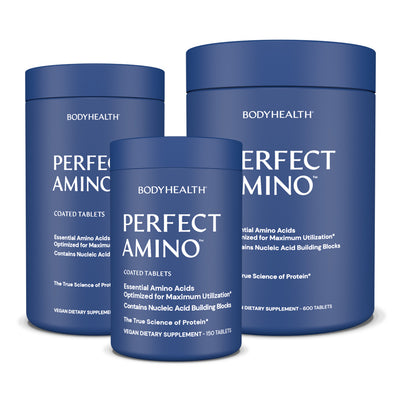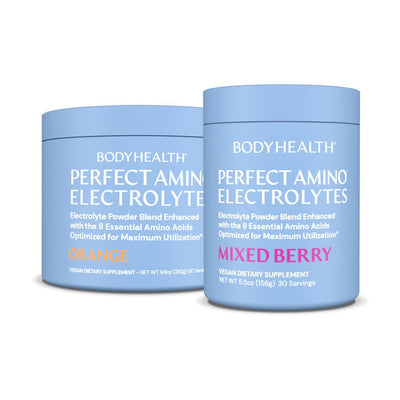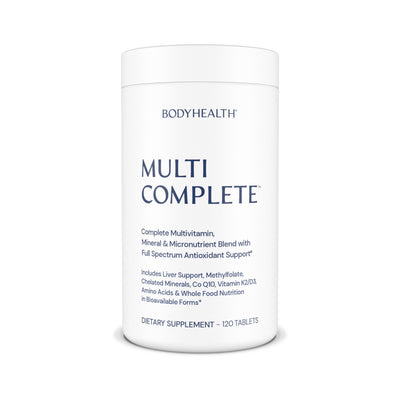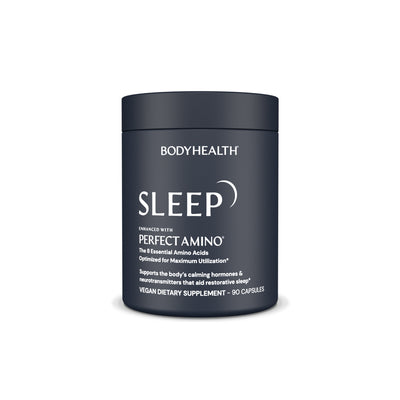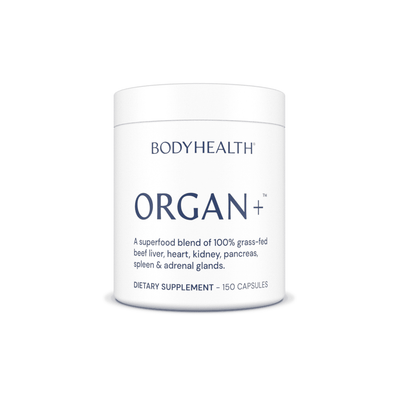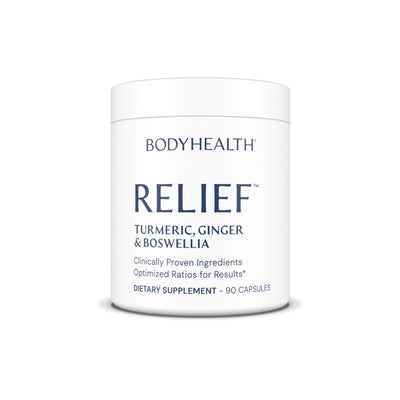What Is HRV & How Does It Affect Recovery & Health
by Dr David Minkoff April 14, 2024 7 min read

We're coming to the end of the Lean Body/Lean Bulk Protocol, and there's one more key aspect to cover for your continued gains.
Yes, if you follow this protocol exactly you will achieve the results it lays out:
Either the lean, toned and shaped body you want (Lean Body), or the ability to build lean muscle without the excess body fat of bulking and cutting, while at the same time losing excess body fat (Lean Bulk).
However, there are certain things that can stand in our way that we don't see, and these can cause reduced gains, lower our ability to recover, and even affect our overall health and longevity.
Overtraining is one, and while it's usually obvious, sometimes it's not quite as visible. But it's important to know, as taking a day off if we're experiencing overtraining provides more gains than putting in that workout would.
Especially as we get into higher and higher performance, the ability to dial in on this precisely and balance it becomes quite important.
Health troubles can also exist without us knowing, and these can both get in the way of our gains, but also lead to troubles we can see later on, if only because they've gotten worse.
But if these things are still too small to see right now, then how do we know? And how can we catch them before they become a problem?
The body is a complex contraption full of very exact systems and a thousand different factors influencing its overall health and performance in one way or another.
We need to be able to separate out the important factors that allow us to measure our overall health, performance and recovery ability, and spot potential health troubles before they become a real situation.
And that’s where Heart Rate Variability comes in.
Heart Rate Variability, or HRV, is a literal measuring stick of our current health and how well our body is able to adapt and recover. And it’s something we can use to monitor ourselves.
Whether we're into extreme sports and maximum physical performance, or trying to achieve optimal health for a long life, learning what HRV is, and how to use it, puts our health and performance in our hands.
This helps us spot trouble when it’s still a ways away, so we can handle it before it gets out of hand.
WHAT IS HEART RATE VARIABILITY (HRV)
While Heart Rate measures the amount of beats per minute of your heart, and Resting Heart Rate measures the amount of beats per minute when your body is at rest (not active), Heart Rate Variability measures the natural variation in time between beats.
When we measure heart rate (how many beats per minute), we’re getting a large picture of how the heart is doing. For example, if we’re running or exercising, our heart speeds up. Then, when we’re resting, it slows down.
If it was speeding up while we were at rest, we’d know we had a problem.
But while Heart Rate shows us the big picture, Heart Rate Variability, or HRV, shows us the smaller details of how things are doing internally.
This is because it’s controlled by our Autonomic Nervous System, the system that controls the involuntary functions in our body: breathing, digestion, heart rate and blood pressure.
It’s the system that controls our organs, that sends messages to wake us up or put us to sleep, that oversees cellular repair and recovery and tells the hormones when to go to work or not.
And measuring our Heart Rate Variation is our way of seeing how the Autonomic Nervous System (ANS) is doing, and how able to it is to keep everything running and deal with the stresses we put on it, or not.
But while we want our Resting Heart Rate to be lower, we want our HRV to be higher — greater variation.
This is because the more our ANS is able to vary the time between beats, the more able it is to address stress or needs we put on it.
And a lower HRV, less variation, indicates that our body’s ability to deal with stress (physical, mental and emotional) is less, and that it’s very possibly dealing with things we may not know about.
HRV gives us a snapshot of the body’s ability to recover, how able it is to recover from illness, injury, or just the stress we put on it daily.
It shows us the pain and inflammation levels of the body, even when they’re hidden (yes, they can be hidden when long-term, as we can gradually go numb to them, causing problems we don’t see), and how well our body is able to deal with them.
It shows when the body or mind is stressed, when cortisol levels are high, when inflammation is high, when we have a possible hidden infection, and if our nervous system is ramped up in fight or flight mode when it shouldn’t be.
These stress points build up in the body, overloading the Autonomic Nervous System. The more individual stresses we have on us, internally or from life, the lower our body’s ability to deal with things becomes.
That’s what HRV shows.
This is a very important indicator of overall health and what the body may be coping with that we don’t see.
When we ignore it, or don’t know about it, it can lead to drastically reduced health, poor athletic performance, and slow recovery from illness or injury.
For instance, we could check our HRV and see that it’s low and say, “well, yes, I’ve not been sleeping well and need to get more sleep,” or, “I’ve been over-training, I need to let my body rest for a day or two.”
These would be points that are putting too much stress on our body and raising cortisol levels.
But what if it was low and we didn’t know why?
Now we can have it checked into: Is it low amino acid levels causing inability to recover? Too much sugar? Inflammation in the blood vessels? A hidden infection? Liver or kidney trouble? Heart trouble?
Or is it a number of things, any one of which, lowered, would raise the body’s ability to deal with the rest.
HRV alerts us to something going wrong inside the body so we can then find out what it is, and address it before it becomes a situation.
It gives a way to be in control of our health.
Even if there is nothing majorly wrong, if too many stress points build up, then over time things will go wrong.
If we know this, we can start spotting individual points of stress and remove them, raising the body’s overall ability to handle the other stress points.
We don’t have to handle them all, we just need to remove them to the point that our nervous system isn’t overloaded with them, so it can deal with the rest.
This makes a drastic difference in our energy levels, mood, strength and ability to recover from workouts, injuries or just day-to-day life.
USING HEART RATE VARIATION FOR IMPROVED HEALTH & GAINS
There are many ways for us to measure HRV. One of the best, currently, is something called the Oura Ring.
You wear it and it connects up to an app on your phone, and you’re able to measure not just your HRV, but other points affecting your HRV: how much sleep you’re getting, how much deep sleep you’re getting, and even your body temperature and calories burned, which show us how our metabolism is doing.
By knowing our HRV we can now spot when we need to pull back from a workout or training session one day to get a bit more rest, or not work quite so late one night, or take a walk or get more amino acids, etc., before we really overload the body.
We can spot when something isn’t right and get it checked out by a doctor and handled before it becomes a situation.
And we can see when our body is stressed (which will also cause us to feel stressed) and know that we need to remove some of the stress points we can see, to help lower overall stress levels so things don’t start going very wrong.
It’s very simple, but quite powerful.
And make sure you're taking your PerfectAmino, extra if necessary on days where you have overtrained, is this contains the key amino acids necessary for you body to perform the recovery and repair it needs right then.
Electrolytes are also very important as when these are depleted it lowers the performance of our nervous system which regulates the whole recovery process.
And make sure you're taking your vitamins as each one is necessary for some aspect of cellular repair and energy creation.
Doing the above puts your current and future health and performance in your hands.
I hope this helps.
If you haven’t seen the Lean Body/Lean Bulk Program, check it out and do the 30-Day Challenge. It’s very effective.
And make sure to join our VIP Group where you can ask any question you have and get only the best answers.
Index To The Lean Body/Lean Bulk Guide:
Introductory Articles:
Getting Started:
- The Lean Body/Lean Bulk Guide & 30-Day Challenge
- Hormones: The Third Dimension of Calorie Cutting
- The Lean Body/Lean Bulk Diet
Supplements & Macros By Goal:
- Supplements & Macros For Lean Body
- Supplements & Macros For Beginner To Moderate Lean Bulking
- Supplements & Macros For Advanced Lean Bulking
Workout Regimens & Exercise Videos:
- Beginner to Moderate Level Workout Regimen
- Advanced Workout Regimen
- Lean Body/Lean Bulk Exercise Videos
Week One:
- Metrics & Key Data For Week One
- How BCAAs Build Body Fat & Lower Health Over Time
- The Importance Of Complete Protein Digestion
Week Two:
- Dialing In Our Macros For Lean Muscle: Hormones & Cravings
- How Cortisol Breaks Down Muscle & Prevents Protein Synthesis
- How To Improve Growth Hormone, Testosterone & Protein Synthesis
Week Three:
- Thyroid, Estrogen & Progesterone: Speeding Fat Loss & Lean Muscle Creation
- Improving Sleep: Muscle Building, Fat Loss, Mood & Aging
- Maximizing Cellular Function For Endurance & Recovery
Week Four:
- Raising VO2 Max: Endurance, Performance & Recovery
- How Toxins Affect Our Hormones: Building Muscle & Fat Loss
- Blood Flow For Muscle, Fat Loss & Overall Health
Final Week:
- What Is HRV & How Does It Affect Recovery & Health
Articles by Health Topic
Get “The Search for the Perfect Protein”
by Dr. David Minkoff
Signup for the BodyHealth Newsletter and get a FREE digital copy of "The Search for the Perfect Protien" by Dr. David Minkoff and discover the key to weight loss, depression, fatigue, insomnia, and osteoporosis!
*These statements have not been evaluated by the Food and Drug Administration. These products are not intended to diagnose, treat, cure, or prevent any disease.
